The 2021 UEFA Women’s Champions League reached its climax on Sunday night, with WSL champions Chelsea Women facing off against Primera Division winners Barcelona Femeni for the ultimate prize in European women’s football. The match in Gothenburg attracted plenty of attention, and was one of the most-anticipated matches of the season.
In this tactical analysis, we will look at Barcelona’s intense attacking start, as well as Chelsea’s mistakes and attacking improvements in the second half. Ultimately, this analysis will highlight the reasons why Chelsea’s slow start led to their downfall, whilst also reflecting on how Barcelona’s clever game plan meant they didn’t need to work too hard for the win.
Lineups
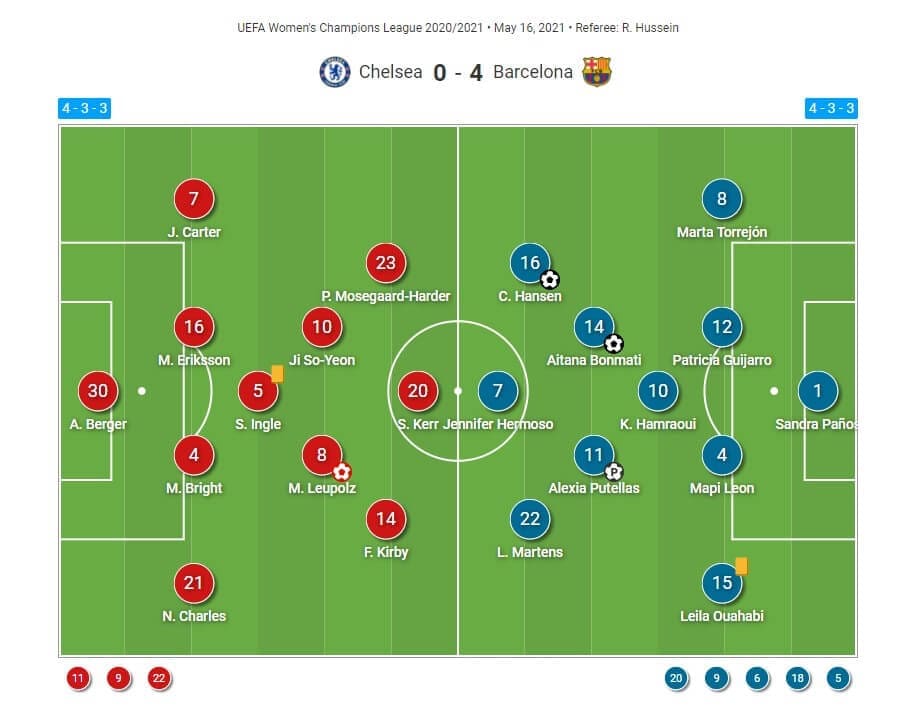
Chelsea Women made no changes from the Reading Women win on 9 May, which sealed the domestic title. That meant that winger Niamh Charles and versatile midfielder Jess Carter again played as full-backs, with Sweden’s Jonna Andersson on the bench and Norway international Maren Mjelde still recovering from a long-term injury. South Korea playmaker Ji So-yun lined up alongside Germany and former Bayern Munich midfielder Melanie Leupolz and Wales’ Sophie Ingle in midfield, whilst Australia striker Sam Kerr led the line, flanked by England’s Fran Kirby and Denmark star Pernille Harder.
Barcelona Femeni, meanwhile, made three changes from their Primera Division clash with UDG Tenerife, also on 9 May. Defender Jana Fernandez, wide attacker Mariona Caldentey and forward Bruna Vilamala all moved to the bench, with first-team regulars Mapi Leon, Caroline Graham Hansen and Jennifer Hermoso coming off it to start. Leon partnered midfielder Patri Guijarro in central defence, with France’s Kheira Hamraoui reverting to midfield and centre-back Andrea Pereira suspended. Norway international Hansen played in her usual right attacking role, whilst Spain star Hermoso led the line through the middle.
Barcelona Femeni’s attacking tactics
Before we focus on Chelsea Women’s errors, we need to look at Barcelona Femeni’s game, as they were on the front foot from the first minute.

Something we have become accustomed to seeing from the Spanish side is an ability to get into spaces behind the opposing defenders. Against PSG Feminine in their semi-final, they constantly looked to put pressure on the French side at the back, and it was the same story here. Chelsea’s defence is narrowly organised, but with gaps open between each player, and this is where Barcelona look to run through and create passing options behind them. The fact that there are three players running through demonstrates how Barcelona’s aim was to dominate the game in this way from the early stages.
We also see how Netherlands forward Lieke Martens is on the left wing, in open space. This ensures that, should Chelsea close the gaps centrally, cutting off those passing options, there is still a way for Alexia Putellas to move the ball forwards and for Barcelona to continue their attack. Therefore, it was clear how, from the opening minutes, the Spanish side were very much in control of proceedings.
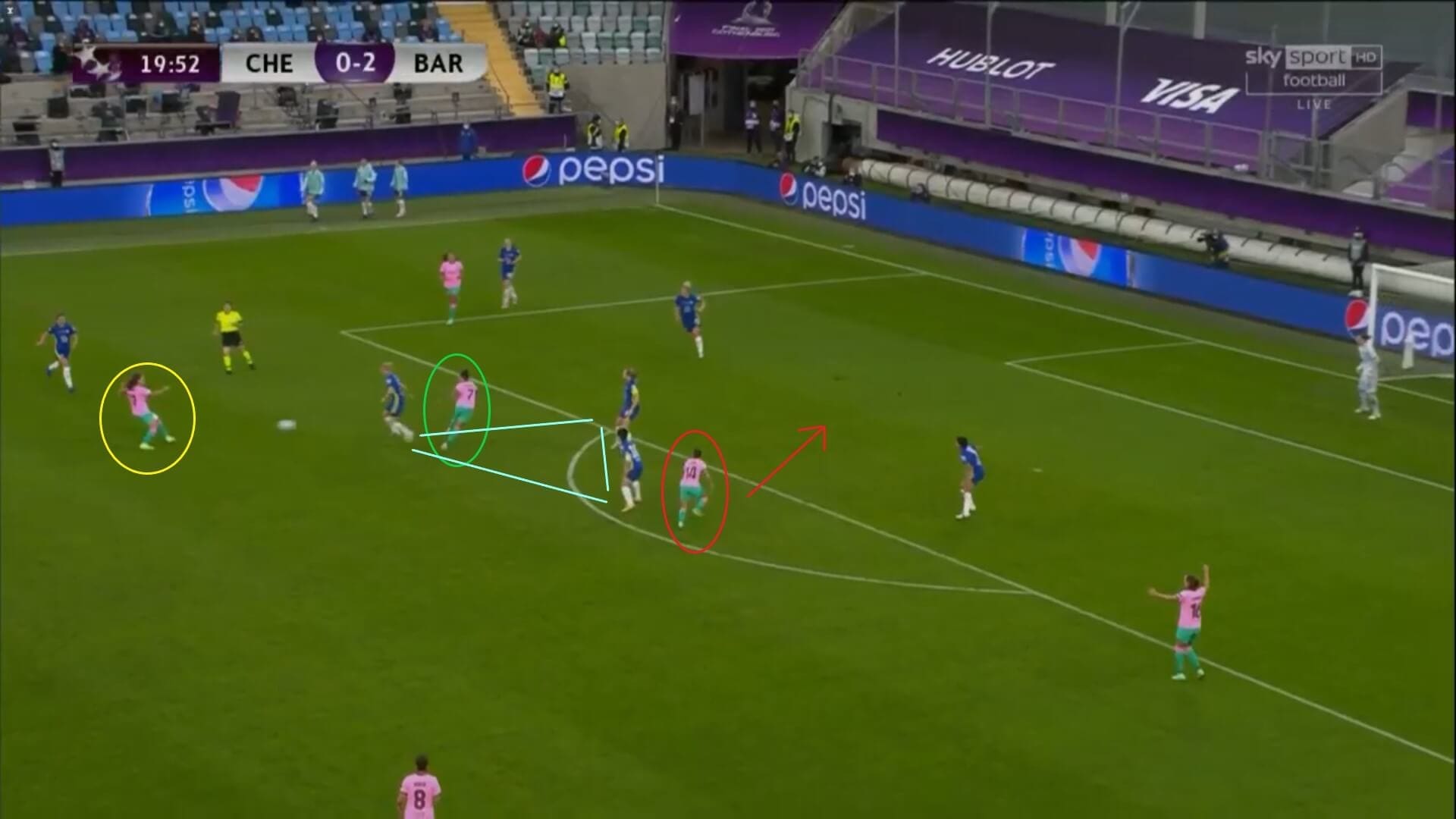
They constantly found spaces in Chelsea’s third, punishing the English champions every time they got into dangerous areas. Here, we see how the ball is on the edge of the area, with Jennifer Hermoso, in the green circle, moving towards it. She doesn’t want the ball, but wants to draw the Chelsea defenders out of the box instead. This, as we can see, leaves the gap open for Aitana Bonmati to run into, with left-back Jess Carter unable to prevent their third goal of the game from being scored.
Dropping deep like this is a regular feature of Hermoso’s play, and yet Chelsea fell into her trap, instead of holding their line and blocking off access to the goal. The speed at which the move happens also shows how this is a well-practiced tactic of Barcelona’s, with Putellas playing a perfectly-weighted pass into Bonmati to set up the goal. Therefore, we see how Barcelona did nothing different to what was expected, but Chelsea simply gave them the opportunities to dominate play and find the spaces.
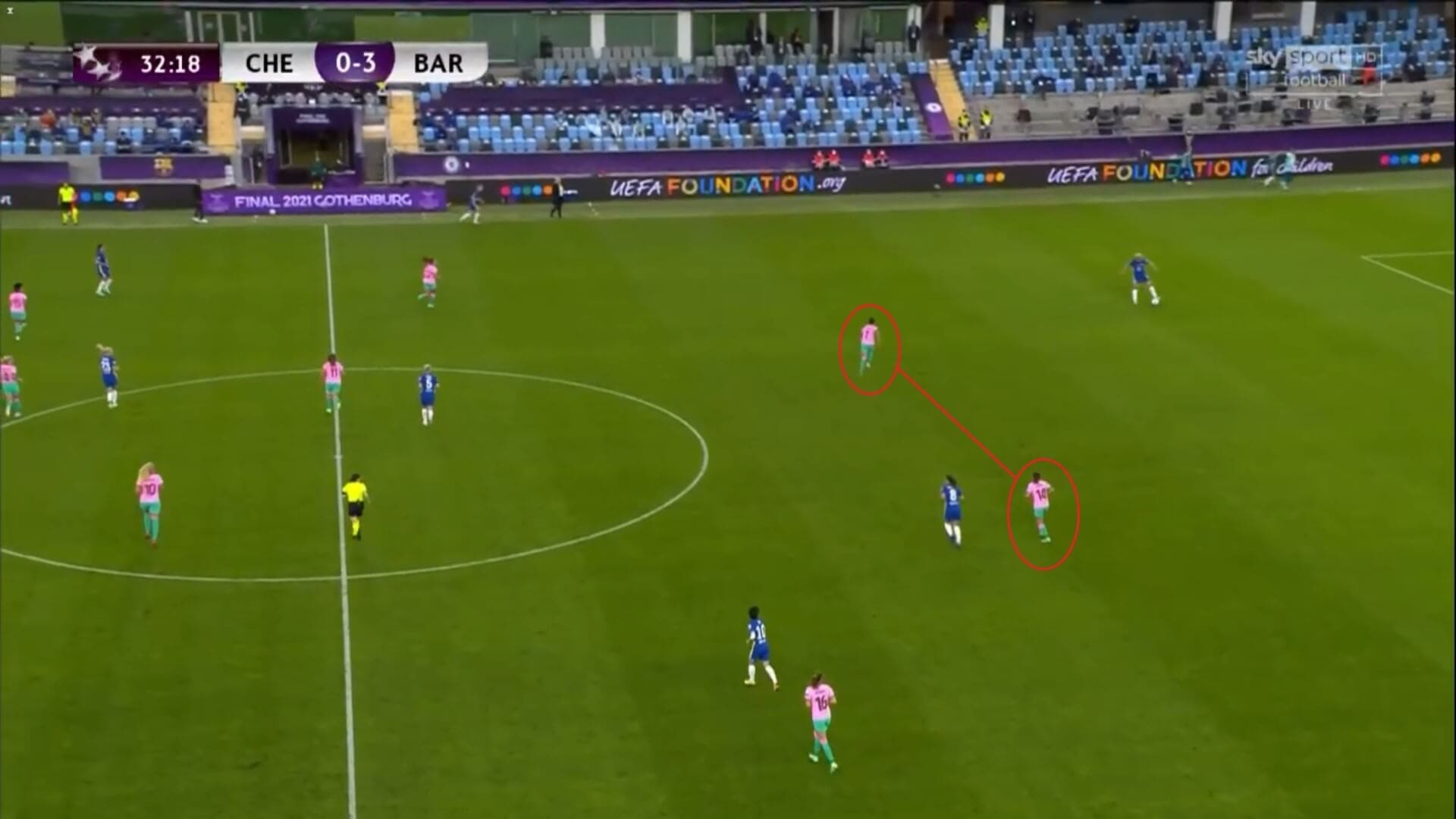
When out of possession, Barcelona set up in a way that limits their opponents’ passing options without using too much energy. Their fluid attack often becomes a front two, with either Bonmati or Putellas running forward to play alongside Hermoso. This creates the structure in the image above, with the two forward players sitting just in front of Chelsea’s defence, positioned wide enough that they can control the play, but not so that a gap between them is opened up for Chelsea to pass through.
With this in place, they could force Chelsea to play sideways passes across the pitch, shadowing the ball and blocking off any possible forward passes. Chelsea spent a fair amount of the first half with the ball in their own third, unable to find a way through, and this was the tactical reason for that.
Overall, Barcelona had to play their own game to come out on top, but didn’t have to work too hard to force opportunities. This was because Chelsea allowed them to dominate the play, which is what we will now focus on.
Chelsea Women’s errors
Chelsea Women came into this game in good form, but, for one reason or another, struggled to settle into it. This is possibly because of the way Barcelona Femeni limited the space they had to operate in, but another big reason was the errors that Chelsea made throughout.
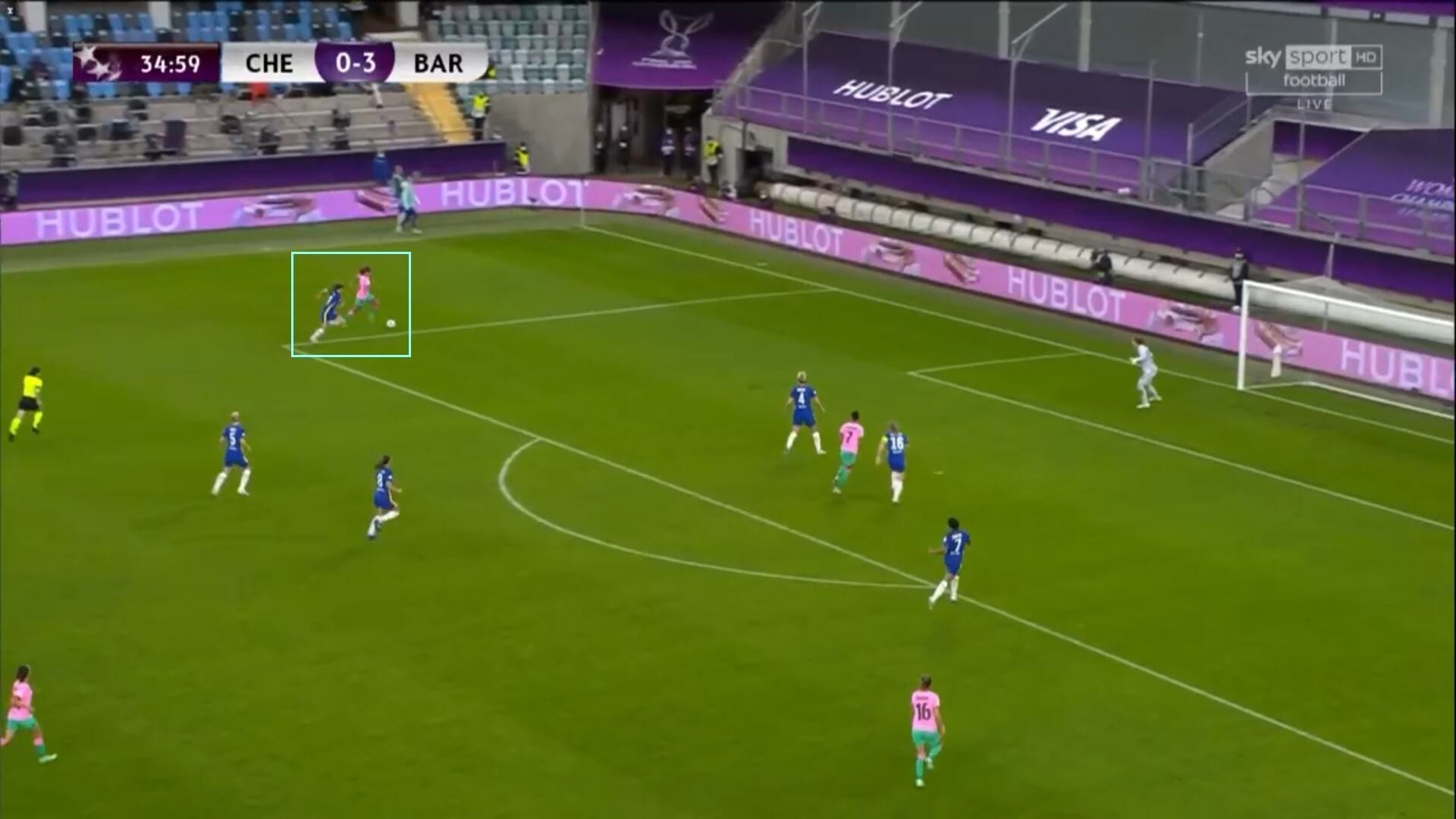
The biggest problem was the full-backs. Both Niamh Charles and Jess Carter are good players, but both struggled to match the pace of Barcelona’s wide attackers, Caroline Graham Hansen and Lieke Martens.
This image shows one example of Martens getting past Charles in the first half, opening up the opportunity to transfer the ball into the box. Charles seemed to be unsure of whether to close the Dutch international down or stay back and close off the space, and often got caught in two minds, which led to moments like this happening. Time and time again, Barcelona used the wings to great effect, taking the ball behind Chelsea’s defence and creating opportunities to score, and this run led to Martens setting Hansen up for Barcelona’s fourth of the game, so we can see how clinical they were when in the final third, and how Chelsea gave them opportunities to score.
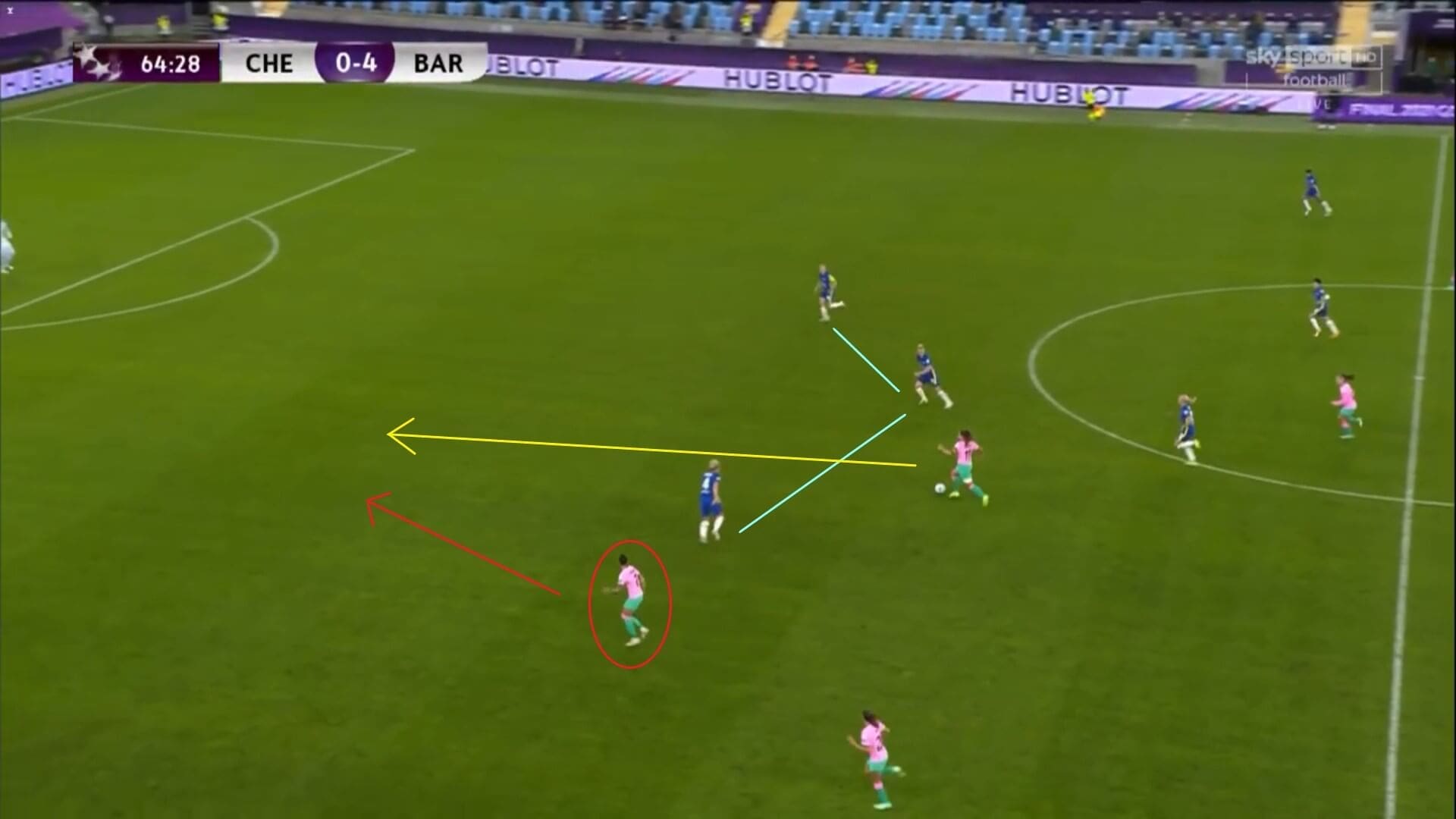
Chelsea also played with a high back line, leaving space open behind for Barcelona to exploit. In this image, Putellas has a gap in front of her to play the ball through, whilst Chelsea’s narrowness means that Hermoso, in the red circle, has plenty of space to run through and meet it. The Spain striker ends up shooting into the side netting from this opportunity, but this is another key aspect of Barcelona’s attack which we have seen many times before, and yet was something Chelsea didn’t prevent. When we consider how much space Chelsea had behind them, it really is no surprise that the Spanish side were so dominant in attacking situations.
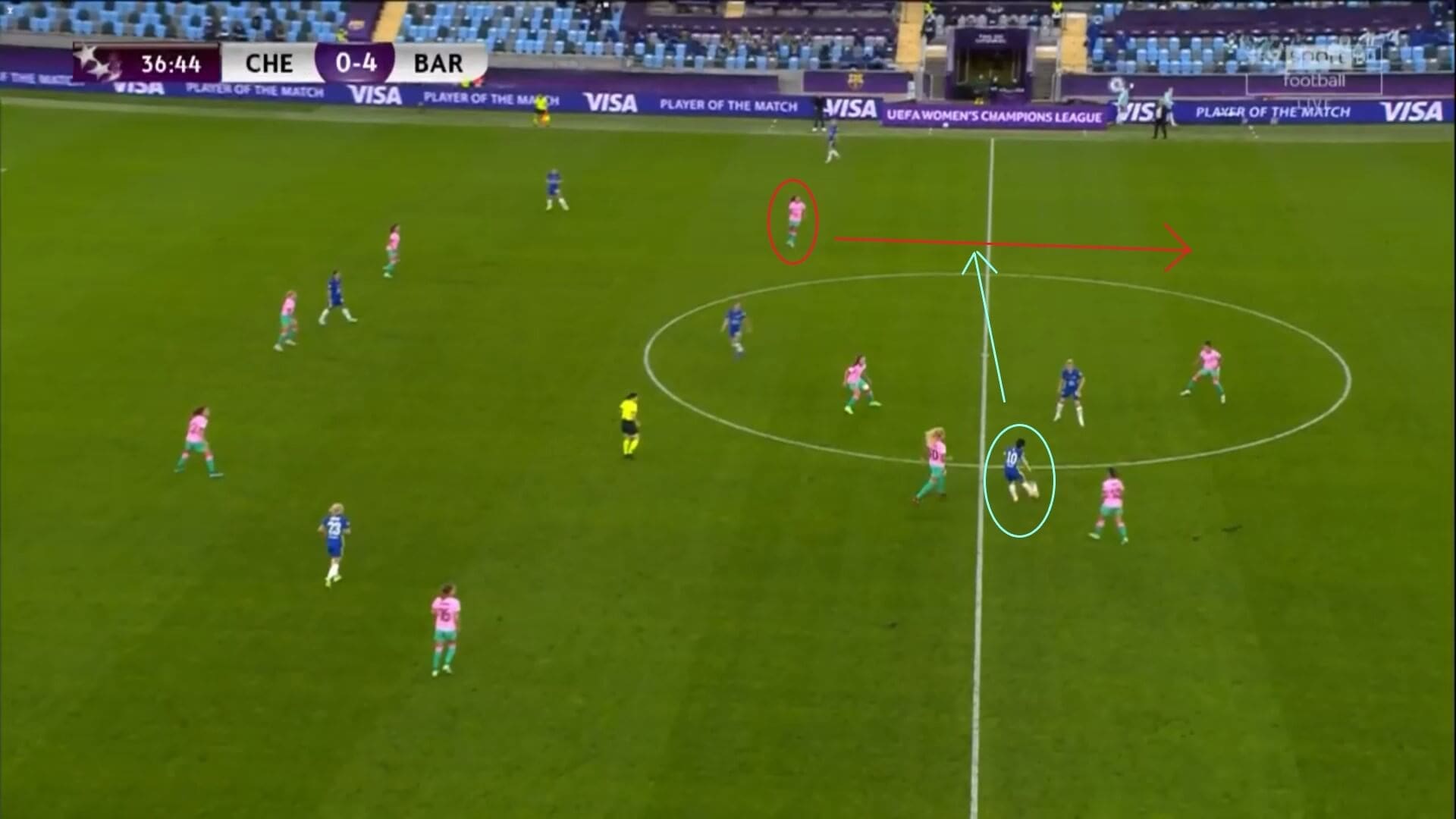
Leaving space open wasn’t Chelsea’s only problem though. Whenever they had possession, they struggled to build any momentum, which came down to poor accuracy at times. Here, Ji So-yun is looking to play the cross-field pass, but doesn’t find a teammate, and the ball is intercepted by Martens, who then runs forward to launch an attack for Barcelona.
Therefore, Chelsea couldn’t get the ball into their dangerous forwards as often as normal, which was another reason they were so quiet in the first half.
When we tally all of these mistakes up, we get a clear picture of why Chelsea struggled to get into the game, and why Barcelona were so good. As mentioned, Barcelona didn’t do anything they wouldn’t normally do, but Chelsea simply played into their traps and allowed them to carry their usual threat going forward.
Chelsea Women’s attack
As well as their defensive issues, Chelsea Women also had problems in attack, particularly in the first half. The image below shows how they had a clear initial game plan, looking to dominate the central areas of the pitch early on.
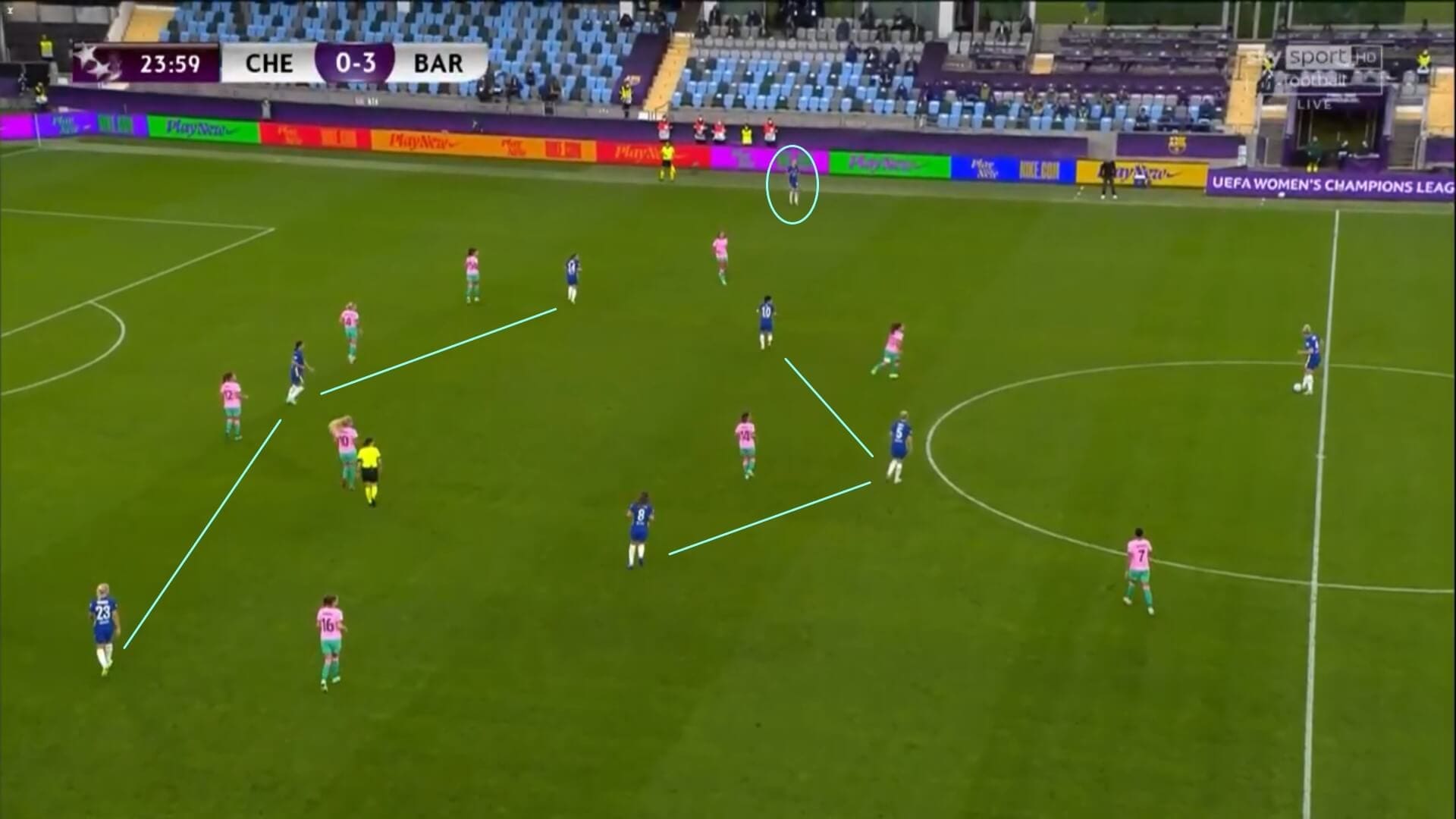
Their aim was to get Niamh Charles and Jess Carter moving up the pitch as much as possible, using them to control the wings. We can see here how Charles’ advanced position gives her teammates a passing option in space, and allows the wide attackers, Kirby and Harder, to cut inside and support Kerr.
The three midfielders have also stayed narrow, working together to limit the space Barcelona have in the middle. This is because Barcelona’s main threats are in the middle of the field, in the shape of Bonmati and Putellas, so Chelsea wanted to force Barcelona to play around them, hoping that that would limit the service to Hermoso.
However, Chelsea didn’t use the wings as often as they could have done, instead looking to pass into the midfield and attack, and this allowed Barcelona to win the ball and launch counter-attacks. Had Charles received the ball from centre-back Millie Bright here, Chelsea may have created an opportunity in the final third, perhaps getting themselves back in the game.
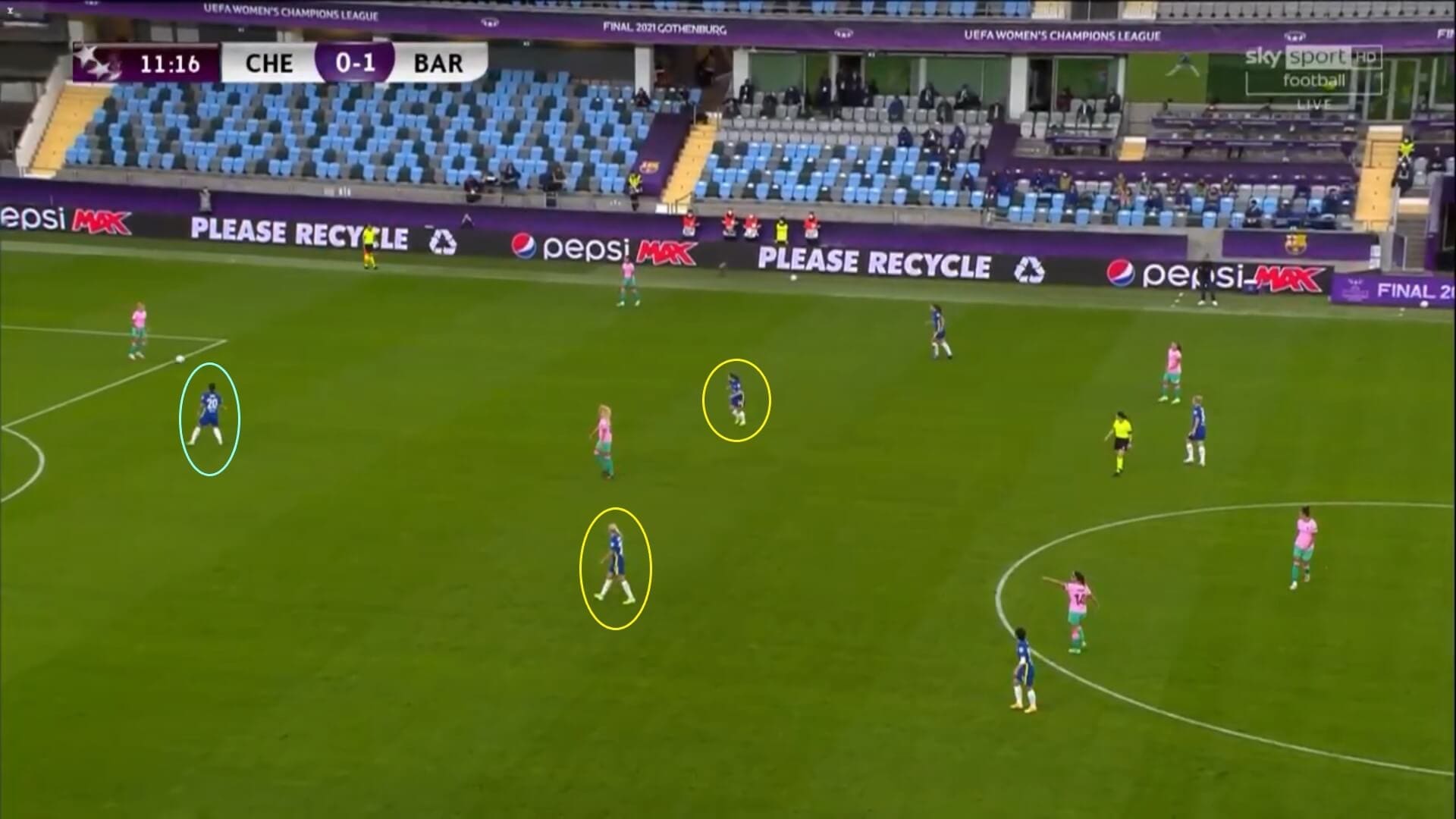
The other problem was that, for all their best intentions with the narrow formation, Chelsea stood off Barcelona too much in the first half. In this image, we see how Kerr has gone forward, but Harder and Kirby have stayed back, playing either side of Hamraoui. This triangular structure defeats their intention to limit the space Barcelona had, because they can now play through the gaps and out of danger. Contrast this with Barcelona’s attacking setup at the start of this analysis, with four players going forward together to maximise the pressure on Chelsea’s defence, and we can see why the Spanish side had so much control of the game.
We have also already mentioned how Barcelona used the wings to great effect, and this was because Chelsea’s poor pressing gave the Spanish side time and space to find Martens and Hansen, using them to get into dangerous areas of the pitch.
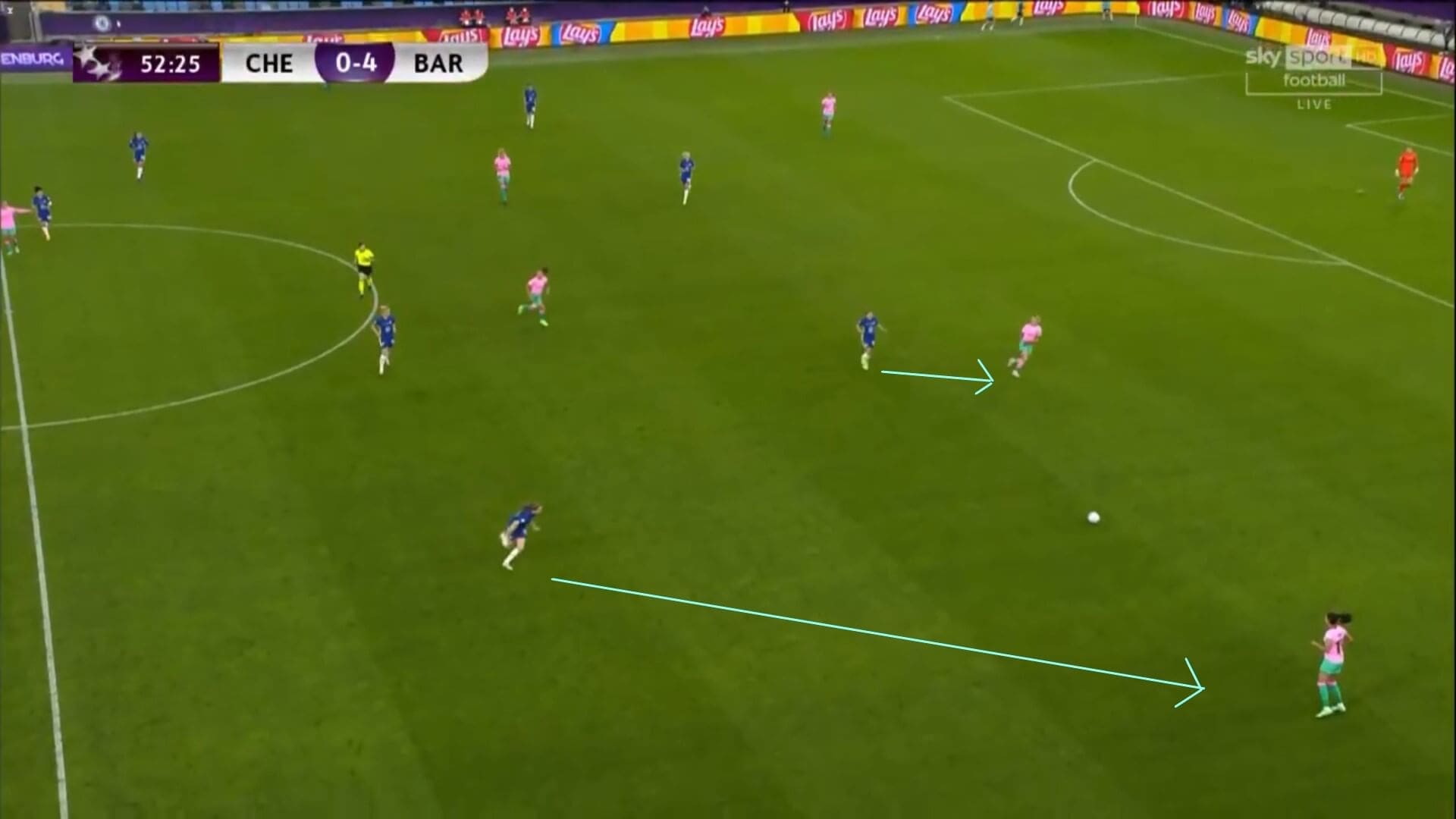
In the second half, there was a notable change in Chelsea’s attacking play, with them getting on the front foot and closing Barcelona down with more urgency. This took time away from Barcelona, forcing them to move the ball quicker and increasing the chance of them making a mistake. Whilst this didn’t happen, it demonstrated the English side’s increased intensity in Barcelona’s half.
Unfortunately, by this stage, the damage had been done and the game won, but this positive change will give Chelsea confidence that they can compete with teams like Barcelona in the future. This is the type of play we normally expect from them, but it had been missing in the first half, and that slow start had cost them their chance of winning the Champions League for this year.
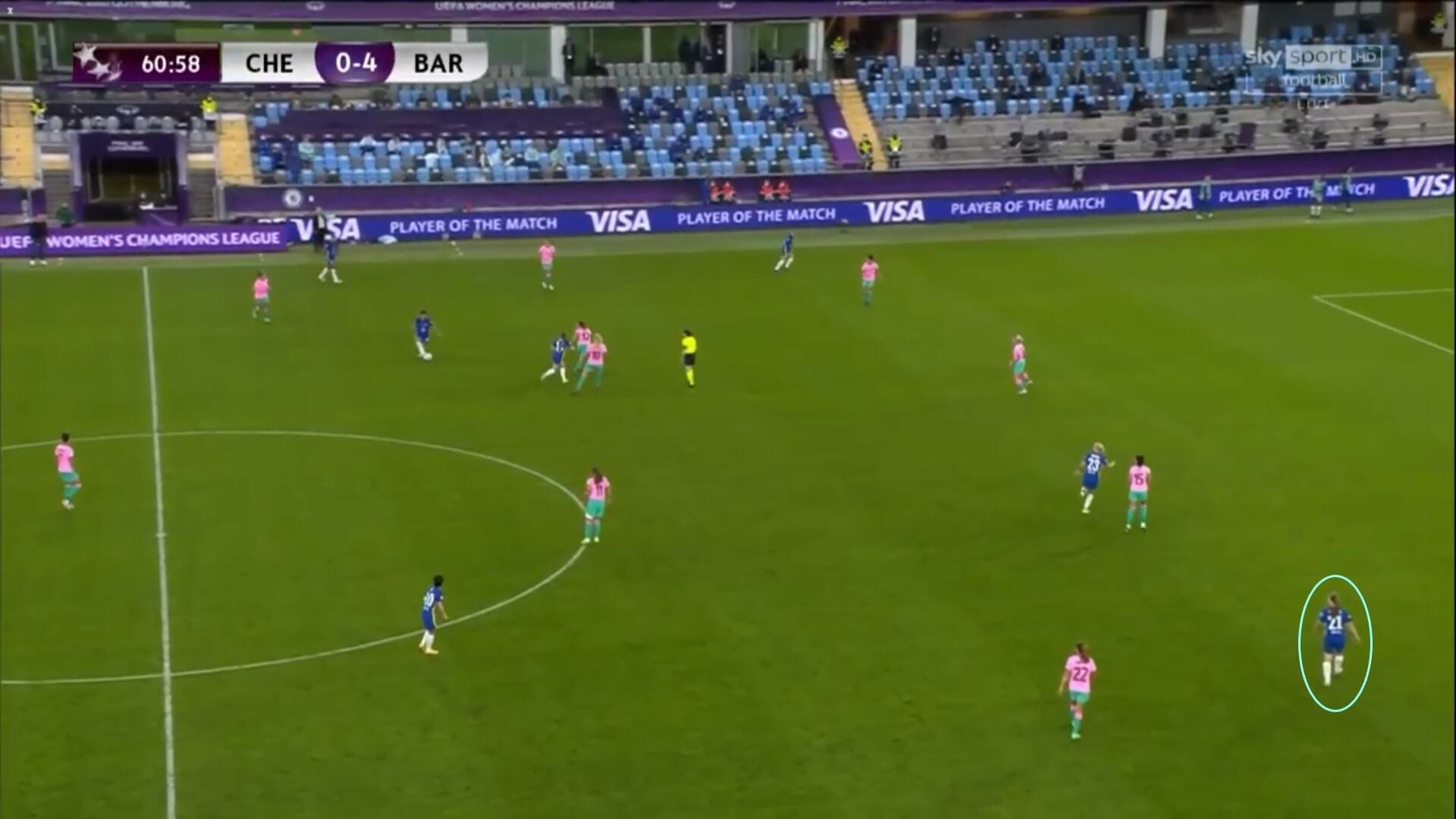
The other attacking alteration they made was to release Niamh Charles from her defensive role. The former Liverpool player is a forward by trade, and looked much more comfortable in the final third than she did in her defensive role. We can see here how she played almost alongside the forward line for the majority of the second half, giving Chelsea more passing options in attack.
This switch of role for Charles, as well as the second-half introductions of Norway attacking midfielder Guro Reiten and Scotland midfielder Erin Cuthbert, helped Chelsea to pose more of a threat, and to play with more of the intensity we expected from them in the first half, but which had been missing.
Their main problem in the second half was that, when they did get into good positions, they couldn’t convert their chances. However, the fact that they got into those areas in the first place shows the positive changes they made in the second half.
Conclusion
In conclusion, this tactical analysis has shown the differences between Barcelona Femeni’s and Chelsea Women’s performances in the 2021 UEFA Women’s Champions League final. Barcelona were on the front foot from the start, punishing Chelsea’s defence for leaving spaces open, and this was what contributed to their four first-half goals. Chelsea, meanwhile, looked a shadow of themselves in the first half, but played much better in the second. By Emma Hayes’ admission, the game was over before it had begun, such was Barcelona’s dominance, but she and others will be wondering if they got their tactics and team selection wrong, given the impact that Reiten, Cuthbert and a freer Charles all had in the second half.





Comments